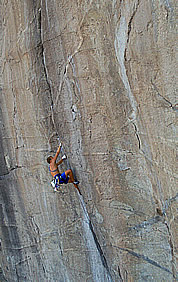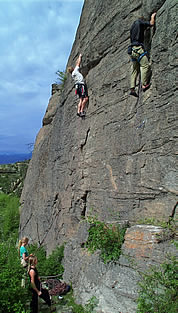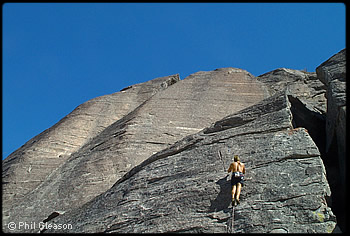 |
 y
knowledge of rock climbing activities in the Omak area dates back to the
early 1970s. Undoubtedly, mountaineers seeking practice rocks, or
wandering cragsmen looking for solitude poked about the cliffs before then,
but none of them published their activities; indeed, none left any written
note, old piton, nor even a tattered rappel sling that future climbers have
been able to find. We presume their visits were rare. y
knowledge of rock climbing activities in the Omak area dates back to the
early 1970s. Undoubtedly, mountaineers seeking practice rocks, or
wandering cragsmen looking for solitude poked about the cliffs before then,
but none of them published their activities; indeed, none left any written
note, old piton, nor even a tattered rappel sling that future climbers have
been able to find. We presume their visits were rare.
 |
 |
|
Climber on Omak Crack. © Phil Gleason. Enlarge |
|
 |
In the 70s a group of Omak-Okanogan area teenagers began to explore
the rocks in their backyard. As was common with climbers of that era, they
started out hiking and scrambling, and then scoured books for techniques
that they could use to take their excursions onto more vertical terrain.
Around this time (1975) Paul Gleason from Southern California arrived on
the scene, and stimulated the “locals” with his import of techniques
learned from the Sierra Club’s programs in the ’60s in
the Los Angeles area. The active Omak clan then included Paul, John and Jim
Goss, Kurt Danison, Jerry Donner, Chuck Split, Bruce Thompson, and Rob Jeter
among others.
Typical of American climbers in the ’70s, these climbers were
heavily influenced by an expanding ecological consciousness that affected
most of us at that time. Not only with regard our earthly environment in
general, but also in the preservation and protection of the crags, a new
attitude was reaching national popularity. With an ethical system supported
and fueled by the now famous 1972 Chouinard catalogue, this group of climbers
adopted the strictest (cleanest) of “clean climbing” philosophies:
no bolts, no pitons, no aid climbing. If a route couldn’t be climbed
free with nuts, it was to be left to the birds and the chipmunks.
Also, a strict no publicity maxim was enforced: no guidebooks, no magazine
articles; one was even to be careful talking about the climbs. For the most
part, these climbers believed they were here to respectfully share this scared
ground with the spirits of the earth, and this sense of respect included
a strong conviction that broader visitation by outside climbers would only
foul the nest. Although these ethics may now seem a bit extreme and counterproductive,
one could consider they sprung from at least three rational concepts: “territorial
imperative”–the local climbers grew up with this as their backyard; “ecological
logic”– fewer climbers equals less environmental impact; and
(to quote Chuck Pratt’s advice), “keep your mouth shut” when
you ‘find’ a
new climbing area – what really is to be gained when you tell everybody?
And so the 70s unfolded as a period of daring climbs, few climbers
and many adventures. Numerous first ascents were not recorded. Paul Gleason,
a protégée of John Gill and a mentor for John Long, was most
likely at his bouldering and free soloing apex when he climbed around Omak.
But he kept quiet about his bold ascents. Other members of this group also
ventured up onto unknown territory.
Of the many brave outings during that era, one remarkable ascent, the west
face of the Lake Wall (AKA Eagle Cliff) deserves mentioning. Jim and John
Goss, with a handful of homemade nuts and a single rope, headed up this muti-pitch
route to overcome difficulty and danger with courage and skill instead of
technology and tools. This exploration stands as a signature climb of an
adventurous spirit that would all but disappear as an approach to the climbing
of these rocks.
The 1980s brought at least two new teams to the Omak area: Mitch Merriman/Herman
Harrison and Bruce Tracy/Phil Gleason. As young climbers, Mitch and Herm
were active in the Omak area as well as elsewhere in Washington. Mitch in
particular (often with other novice climbers) started his climbing career
in the Okanogan County. As often happens with beginner rock climbers who
learn climbing through their own discovery, Mitch had many close calls and
exciting
adventures.
Mitch contributed the following in a recent e-mail:
I started climbing in the Omak crags in the summer of 1982, mostly top
roping and rappelling shenanigans such as befitted my lack of training. I
knew how
to tie a water knot, figure eight knot and a double fisherman’s knot
and I knew how to hip belay and rappel with a carabineer brake (4-oval carabineers)
and whatever else I could glean from the pages of Mountaineering: Freedom
of the Hills. My gear consisted of an 11mm x 45m rope, two locking
Carabineers, four oval carabineers, 12 feet of 1” tubular [webbing]
that I tied leg loops in and wrapped the rest around my waist for a harness,
and 30 feet of 1” tubular for rigging anchors (slinging boulders, Ponderosa
Pine trees, mock orange, serviceberry shrubs or equalizing sagebrush bushes).
My shoes were leather hi-top converse basketball shoes that I would periodically
sew the soles back onto with dental floss. I and whoever I could trick/coerce
into it would top rope mostly on what I believe is now called “The
Practice Wall.” They were fifteen foot routes from 5.2 to 5.9. I took
an unroped fall while soloing in a 5.2 chimney…the first time of many
in which I really should have died.
 |
 |
|
Omak Rock. © Phil Gleason. |
|
 |
Mitch goes on to relay a horrowing tale of a top-rope gone bad, where he
set out to climb a mossy chimney with an anchor that had been set for rappelling
practice, about 25 feet horizontally out of line with the climb, and he persisted
in climbing this mossy chimney after a thundercloud burst its buttons. “The
higher I got the more the heavy wet rope began to tug me out of the chimney.
I began to feel desperate and called for slack and continued” …. “after
free falling for 20 feet, the slack came out of the rope. My belayer, 75
feet below with a hip belay, had been freaking as badly as I. He had wrapped
the rope multiple times around his body and been backing down the slope.
When I hit the end of the rope after 20 feet of accelerating free fall he
went airborne up the slope for another 20 feet. Neither of us got a scratch.”
Mitch survived the incident and added many fine climbs in the area, generally
in the moderate to 5.9+ range. He and a variety of partners were quite active.
Mitch and Michael Patterson climbed “Danison’s Delight,” in
1984. Mitch and Herman Harrison climbed “Linear Perversions,” aka “Spill
the Wine” on Omak Lake Wall in 1986. Mitch and Tom Bosden climbed a
five-pitch route, “Mitch and Tom’s Excellent Rock Climb” (5.8)
on the Mission Wall in 1989, and with Tom Bowden he climbed another five
pitch line on Eagle Cliff (5.9+) also in 1989.
Editor’s note: readers who climbed in the early ’80s may
recall this as the scariest rating ever before or since given in American
climbing. 5.9+ was reserved for routes that were of un-quantified difficulty,
obviously hard and at or near the top end of what any local climber could
do at the time. There was an ideological aversion to extending the difficulty
scale beyond 5.9 because it was originally conceived of as a decimal system,
and 5.9 had been defined as the hardest possible climb that could be done
without aid. 5.10 didn’t make sense; after 5.9 came Class 6, which
was aid. The rating “5.9+” often went without update because
many of these 5.9+ climbs were obscure or exceedingly run out in addition
to being just plain hard; many popular routes in this range eventually were
re-rated at 5.10 or 5.11.
|
 |
| Background |
| |
 |
| About Phil Gleason |
 |
Phil Gleason has been climbing for forty five years,
and climbing in the Omak area since 1981. He pioneered many rock climbs
in North Central Washington, and has always been an avid photographer;
like many of us, he has taken to producing digital images in more recent
years. Several adorn this issue of the Northwest Mountaineering Journal,
mostly on reservation rock which is currently closed to climbing. He’s
been called Sergeant Rock since early 80’s because he was always
eager to go climbing, sometimes a little early in the morning.
|
 |
| Kurt Danison |
 |
Kurt Danison has climbed in and around the Omak area
for twenty five years, first exploring crags such as the “Mission
Wall” in about 1975. For the last ten years, he’s been more
active in exploring the wild rivers of the Intermountain West. Currently,
his telephone machine says he’s off on “the river of no return.”
We hope not.
|
 |
| Herm Harrison |
 |
Herm Harrison climbed around Omak in the middle
1980s. He still climbs, and was last reported in the Eastern Sierra
about
a year ago. He maintains a fine website that he calls “wormspew.” Check
it out.
|
 |
| Mitch Merriman |
 |
Mitch Merriman was most active in the Omak area from
about 1980 to 1986. Mitch describes a fond memory for the adventurous
nature of traditional climbing on uncharted rock. When questioned in
connection with this article, he said: “watch out for rattlesnakes!”
|
 |
| Rob Jeter |
 |
Rob grew up in the Omak valley and was extremely active
in the '70's and '80's; he currently works for the United States National
Forest Service, based out of Randle, Washington, and does accounting
for timber sales on the Gifford Pinchot National Forest.
|
| |
|
 |



